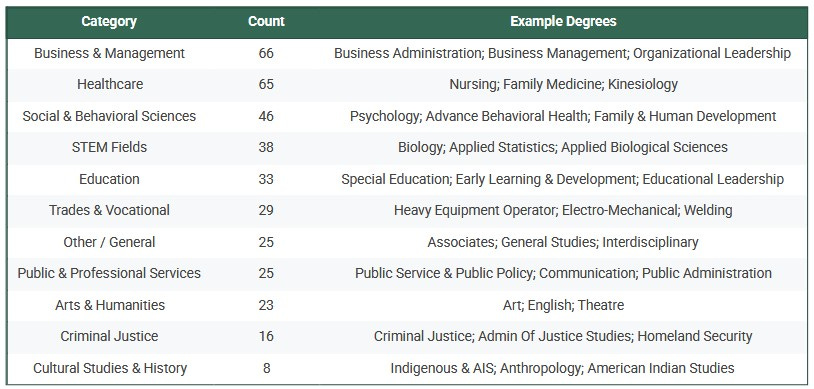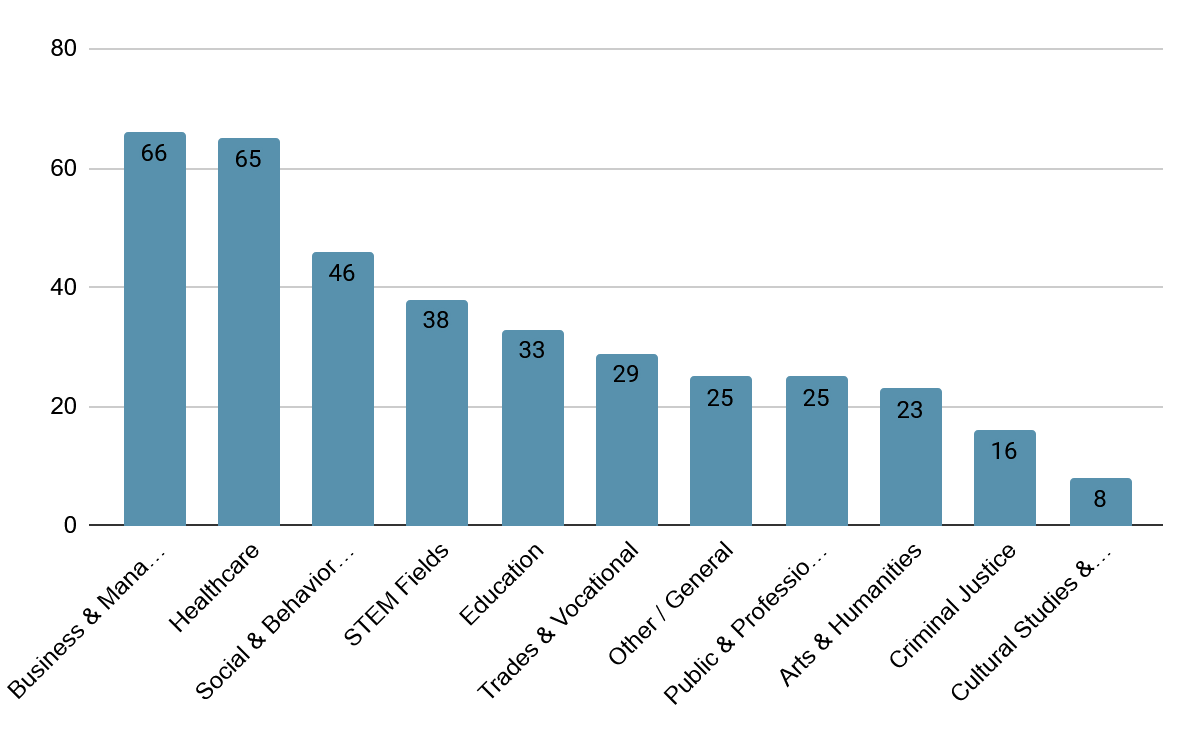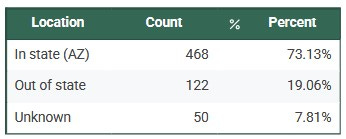A Decade of GRIC Higher Education Data (pt.3)
Second part of a series on Data from GRIC students (2015 to 2024)
This is a continuation of my previous article on GRIC’s higher education program.
Section 5: What Students Are Studying
This section highlights the fields of study most commonly pursued by GRIC students over the past decade.
However, not all graduation announcements in the Gila River Indian News included degree focus information. As a result, this section is based only on records where a field of study was listed.
Note: A significant portion of graduation announcements did not include a field of study. In this dataset, 266 of 640 degrees (42 percent) had no field reported.
Degree Focus (if known)
Key Trends
Business Management, Healthcare, and Social & Behavioral Science are the most frequently listed degree focus areas.
Reflects the GRIC enterprises of Gaming and Healthcare
Cultural Studies and History is the least frequent type of degree
To be honest I am stretching it with this…. there is only 1 degree that really aligned with this category. The rest were American Indian Studies or Indian Law degrees that I’m hoping might be culturally or historically relevant…
Insight
The distribution of degree focus areas over the past decade shows a heavy concentration in Business & Management (66), Healthcare (65), and Social & Behavioral Sciences (46). This pattern reflects the economic and workforce priorities of the Gila River Indian Community, especially the prominence of gaming enterprises and the healthcare sector as major employers and service providers.
In contrast, Cultural Studies & History ranks the lowest, with only 8 (ish) degrees - and even this number is inflated. Only one degree (Anthropology) clearly aligns with this category. The rest are in fields like American Indian Studies and Indian Law, which may incorporate cultural and historical elements but are not primarily designed as cultural, language, or history programs.
This imbalance highlights a critical gap: GRIC needs more students in language, cultural preservation, and history!
While the economic case for business and healthcare degrees is strong, the long-term vitality of Akimel O’otham and Pee Posh languages and GRIC Historical knowledge depends on producing more graduates prepared to teach, research, and lead in these areas.
*NOTE - There is a limitation in the available data. For example, multiple students are known to have completed the Language Teacher Cohort around 2017, yet their degree focus does not appear in the dataset from GRIN issues.
Section 7: Most Attended Schools
Over the past ten years, GRIC students have earned degrees from a wide range of colleges and universities across the country. While 159 different institutions are represented, a smaller number of schools awarded the majority of degrees. This section highlights the most frequently attended institutions.
Common Schools (only Top 10)
Where Are Schools Located?
Insight
Most degrees come from Arizona schools that are close and practical. ASU is the anchor. Community colleges like Chandler-Gilbert, Central Arizona, South Mountain, and Mesa are right behind, which fits the pattern of students using local, affordable on-ramps and transfer paths.
Career programs such as Carrington and RSI also play a big role, pointing to strong demand for healthcare and trades. The most common places GRIC members are attending are in the Phoenix-metro area.
Conclusion
Over the past decade, the accomplishments of GRIC students recognized in the Gila River Indian News tell a clear story: higher education is a growing and evolving part of our Community’s journey.
Most degrees have come from universities and community colleges, with bachelor’s and associate pathways serving as the backbone of achievement. Career-focused certificates, master’s programs, and the small number of doctoral degrees round out the picture, revealing both our strengths and the opportunities ahead.
One of the most striking findings is what’s missing. Cultural studies, language preservation, and history degrees make up only a small fraction of the total — in fact, there is just one anthropology degree in the entire dataset, and no clearly identified O’otham or Pee Posh language degrees. While economic needs make business, healthcare, and professional fields an understandable priority, the long-term vitality of our languages, culture, and historical knowledge depends on preparing more graduates to teach, research, and lead in these areas.
Each row in the dataset represents someone’s hard work, persistence, and support network.
I’ve walked this path myself, navigating an unconventional journey through the same scholarship system that has helped so many others. To close out this report, I want to share my own story of how those opportunities shaped my education, my career, and my understanding of what it means to give back.






